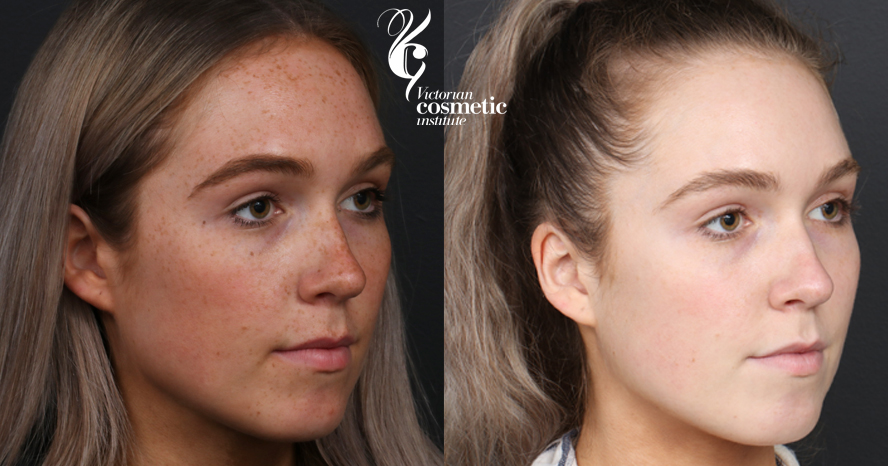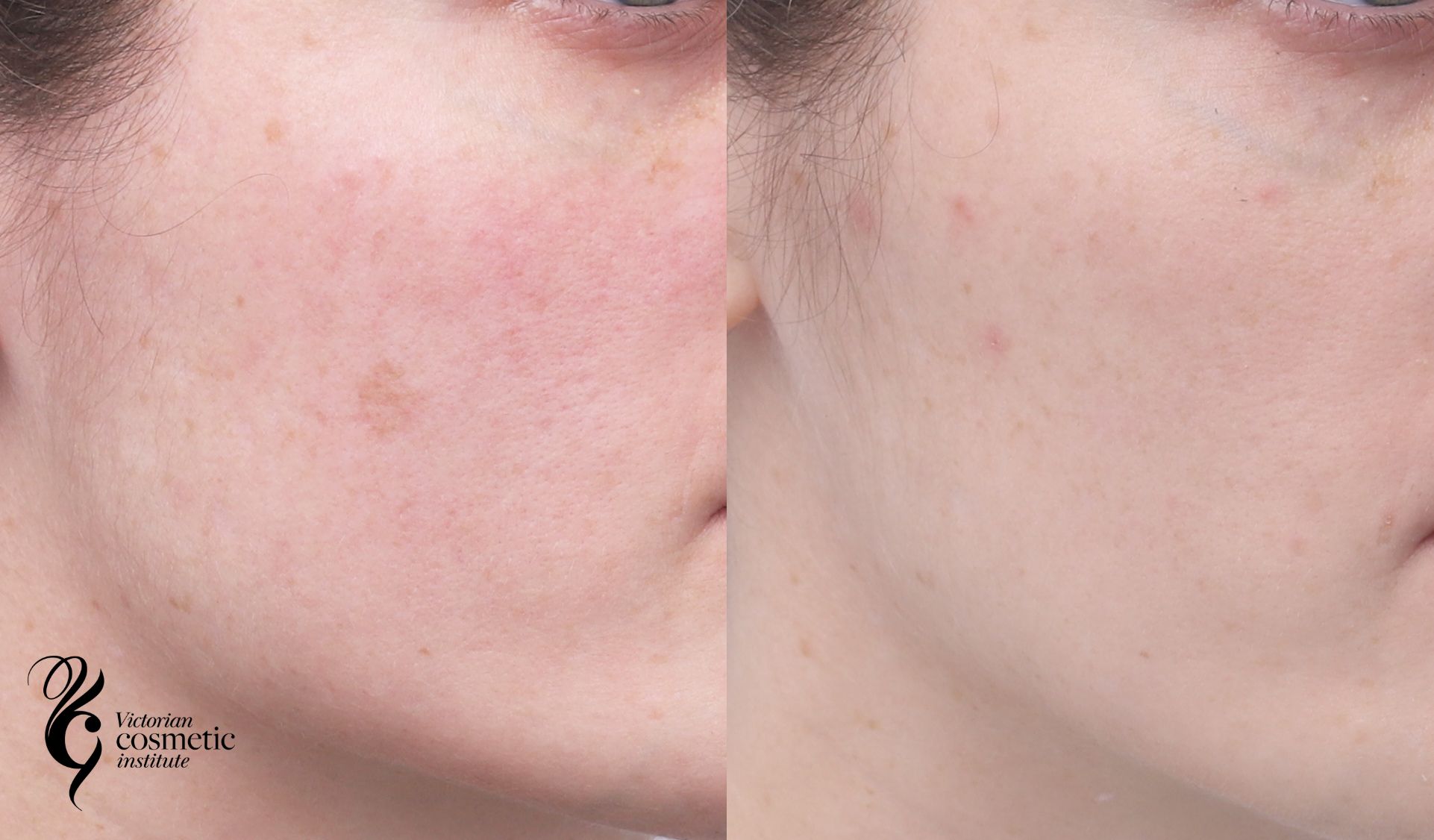What is a Q-switch Ruby laser?
As the name suggests, the Ruby laser emits a ruby-coloured wavelength of light (694 nanometres).
‘Q-switch’ refers to the mechanism by which this laser can emit a pulsed output beam with extremely high peak power.
The combination of the wavelength and the high peak power makes it well-suited to remove tattoo ink, particularly green tattoo pigments and skin pigmentation, including freckles and sun-related pigmentation changes.
In general, the laser light emitted operates by the principle of selective photothermolysis, which is the attraction of particular wavelengths of the laser to certain colours, allowing for the specific heating and targeting of a coloured target.
Also important is the depth of penetration of the laser. The longer the wavelength, the deeper the penetration. Therefore, the 694nm wavelength penetrates much deeper than the 532nm wavelength. This is important for deeper problems such as deep pigmentation removal for birthmarks, Naevus of Ota, Hori macules, Naevus spills, freckles, cafe au lait spots, and other forms of pigmentation.
What can be treated with the Ruby laser?
The wavelength of light that is emitted by the ruby laser is selectively attracted to certain colours in the skin;
- Skin pigmentation the 694nm wavelength from the ruby laser is attracted to the melanin in skin. Although it is not as attracted to melanin as highly as the 532nm wavelength of the Piqo4 laser, it penetrates deeper than the Piqo4 laser and is able to reach deeper unwanted pigmentation. Skin pigmentation is usually performed in the q-switch (short pulse) mode to help to shatter the pigment. Click here for more information on skin pigmentation. Types of skin pigmentation treatable with the ruby laser include;
- Birthmarks – a variety of brown birthmarks can be treated with the Ruby laser. Any raised lesions cannot be treated however. Treatable pigmentation include Naevus of Ota, Hori macules, naevus spilus, congenital melanocytic naevi, and cafe au lait spots.
- Post-sclerotherapy pigmentation This is a particular kind of pigmentation that arises from sclerotherapy, or injections for leg veins. Haemosiderin, a constituent of blood, remains in the skin and causes a bruised like appearance on the skin. The pigmentation has an absorption peak of 410-415nm that tapers down through the remainder of the visible spectrum and can be improved significantly with the q-switched lasers.
- Melasma – this is pigmentation due to hormonal factors, and can be treated with the ruby laser
- Freckles – the ruby laser is highly effective in getting rid of freckles on the body or face
- Sun spots/sun damage – the ruby laser is effective at removing sun spots, although the Piqo4 laser is usually used for this.
- Green, blue, and black tattoo removal the 694nm wavelength is highly attracted to the darker tattoo pigments. Although the 1064nm wavelength of the Piqo4 laser is capable of removing black and dark blue pigments, it is not attracted to green pigment. Therefore, the ruby laser is required to properly treat those who want green tattoo pigments removed. Again laser tattoo removal is performed with the ruby laser in q-switch or short pulse mode and this allows the shattering of the tattoo pigment. Click here for more information on laser tattoo removal.
What will my skin look like after treatment?
This will depend on the strength of the treatment. The skin may appear mildly sunburnt for 24 to 48 hours. For pigmentation removal, the skin may crust and appear darkened for approximately one week. After tattoo removal, the skin may have some small pinpoint bleeding and appear white in colour. The recovery can take some time depending on the aggressiveness of the treatment. Dressings and antibiotic ointment may be required for a few days.
Will it hurt?
Topical anaesthesia can be used to numb the area prior to laser treatments. Especially when higher energies are used, such as with tattoo removal, topical anaesthesia is necessary. Without this anaesthesia, laser tattoo removal is said by some to be more painful than the initial tattoo application itself. If appropriate, an injection can be given to numb the area for treatment.
For lower energy treatments, anaesthesia may not be required.
Ruby laser case study – freckle removal
This patient presented for a single treatment of ruby laser to remove the freckles on her face. Recovery time was approximately 7 days, and a significant improvement in the freckles can be seen.

Ruby laser case study – sunspot removal
The patient presented with a sunspot on her right cheek which she wanted removed. The after photo was taken 2 weeks after 1 treatment using the Ruby laser.

What are the possible adverse outcomes of treatment?
Adverse outcomes with laser treatments are undesired outcomes that occur in a small percentage of patients treated. These include;
- Post-inflammatory hyperpigmentation is a brown mark left on the skin after treatment that usually takes some months to fade with the assistance of lightening agents.
- Hypopigmentation – loss of pigmentation in the treated area (rare). Prolonged redness. Sometimes, the redness of the skin can take longer to fade than expected.
Bacterial or viral infection laser treatments can sometimes trigger herpes simplex outbreaks. Any viral or bacterial infection in a wound created by a laser has the potential for scarring. Scarring a very rare possibility, usually associated with darker skin types, over-zealous energy settings, and bacterial or viral infection.
Why should I choose Victorian Cosmetic Institute as my provide of laser treatments?
At Victorian Cosmetic Institute, we use the latest laser technology to perform your treatment. The Ruby laser is a laser for the removal of pigmentation and tattoos.
Our practitioners are highly experienced in laser treatments, and will be able to give you advice during your initial consultation.
The first step is simply contacting us for your initial laser skin rejuvenation consultation, where we will discuss with you what is a realistic and achievable outcome, and what to expect from your laser treatment.
Consultations are required to determine suitability for treatment. You can call our customer service team on 1300 863 824 or book your consultation online.